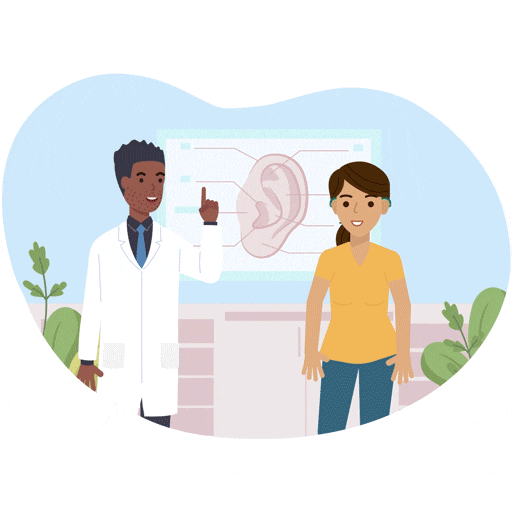
Achieving the right fit is critical to getting the most out of your hearing aids. That's because “fitting" means much more than simply making sure a hearing aid is comfortable in your ear. Hearing aid fittings are a process to help ensure that the technology fits your needs, personal preferences and lifestyle. But first you'll need to understand how hearing aid appointments work, what to expect and what to request.
This guide will walk you through the hearing aid fitting process — along with questions you should ask — from start to finish.
Step 1: Initial Evaluation and Analysis
First, you will have an initial evaluation where you and your hearing care professional work together to choose the best hearing aid for your needs. This includes an initial fitting, followed by a fitting once your hearing aid arrives.
While we may frequently refer to an audiologist in this article, you can get a hearing aid fitting from an audiologist or a hearing aid specialist (sometimes called a hearing instrument specialist).1 Audiologists may specialize in more severe hearing loss cases or balance disorders, while specialists are great for age-related hearing issues.
The initial evaluation usually includes the following steps:
Receive a hearing test
An audiologist will give you an ear exam and a hearing test.2 The results of your hearing test will help determine the type of hearing aid you need. Smaller-sized aids are often better for people with milder hearing loss.
Assess your hearing aid needs
The hearing care professional will review your hearing test and discuss your lifestyle.3 Be prepared to talk about the different listening situations you encounter regularly, such as being at home with little background noise, attending sporting events or the theater, participating in business conference calls or working in a noisy office, talking on the phone with family and friends and so forth.

Point out the times when you experience hearing issues. If you've worn hearing aids before, now is the time to talk about it.3 Was there a reason you quit wearing them? What did you like and dislike about the style?
All of this will help your hearing care professional make recommendations for you.3 If you are a boater, for example, you may need waterproof hearing aids. If your needs change frequently, such as spending time in a quiet environment at home but working in a noisy environment, then you might need advanced digital aids.
Identify types of hearing aids and preferences
Depending on your lifestyle and your hearing test results, you could have a number of different hearing aids to choose from.2 Consider things like color — do you want something that blends in with your skin tone or a bright color that makes a style statement? Consider your lifestyle and what might fit better. Do you need quick recharging? Do you wear eyeglasses? Are there certain features you want, like remote controls, automated volume adjustments or wireless accessories?
Select a hearing aid
After your discussion, your hearing care professional will present you with recommendations for hearing aids that fit your needs and preferences. You'll make your selection, which will then be ordered.
Types of hearing aids
Study the types of hearing aids before you arrive at your appointment, so you can have a better idea of your preference.

You will likely be choosing between two main types.4 Behind-the-ear (BTE) aids sit behind your outer ear and include a tube that connects to a custom mold or pre-made dome within your ear canal. In-the-ear aids (ITE) are molded to fit entirely within your ear canal.
The style you choose may affect options like rechargeable batteries, noise reduction, whether you can have directional microphones that can reduce sounds behind you, telecoils that may work better with certain types of phones, wireless connectivity, remote controls, programming and more.
Step 2: Initial Fitting for Ear Impressions
Hearing aid fittings take place in two stages that are typically spread out over two appointments.2 In the first stage, you will likely get a custom mold so your hearing aids fit better. In the second stage, you'll try on your hearing aid and get it adjusted.
If you choose hearing aids that fit inside your ear, you'll need a custom-fit mold.4 Many types of behind-the-ear hearing aids also require molds, unless you choose a hearing aid that comes with a pre-made dome style. Dome styles tend to have more of an open fit that lets low frequencies enter your ear more naturally.5 But they may be tougher to insert since they aren't custom-made, and they aren't typically the right choice for people with more severe hearing loss. The greater your hearing loss, the more likely it is that you'll need a custom mold.6
The process of getting a mold simply involves using a soft compound to take an impression of your ear canal and outer ear.6 This is similar to when you get impressions of your teeth at the dentist. It's a quick process that might be repeated yearly to ensure a good fit.
Step 3: Final Fitting After Receiving Your Hearing Aids

You'll be given another fitting when you receive your hearing aids in the second appointment, to make sure they fit your ears well and are adjusted correctly.2
The fitting might include real-ear measurements that check how loud sounds are in your ear canal, to make sure the hearing aid doesn't over-amplify anything.2 This involves a tiny microphone inserted in your ear canal next to your hearing aid to check and adjust sound levels.
At this appointment, you will also learn how to use any special features, as well as how to change programs, adjust volume, change the battery, and care for your hearing aids. Make sure you also learn what steps to take if you experience problems with your device. You'll likely return yearly or so to get your hearing and your hearing aids checked, including any needed adjustments.
How Long Does a Hearing Aid Fitting Take?
How long it takes to fit a hearing aid depends on the audiologist's office and the type of hearing aid you're getting. If you've already had a hearing test and you're choosing a hearing aid that doesn't require getting ear mold impressions, then it might just take 15 minutes or so to walk out with a hearing aid.2 However, in most cases, the process will take quite a bit more time.
If you are also getting a hearing test, that will add more time to the fitting. If you are having a custom mold for your hearing aid, then you'll have to return for a second appointment and a final fitting. That entire process might take up to two hours — sometimes a little longer — from start to finish.
Fitting Process for Over-the-Counter Hearing Aids
In late 2022, the FDA approved over-the-counter hearing aids.2 This means you can now purchase hearing aids at a pharmacy or even online. These are often more affordable than prescription hearing aids, and designed for milder hearing loss.7
These OTC hearing aids are self-fitted and don't require a hearing exam or a fitting appointment. Some come with multiple earbuds, so you can choose the one that fits your ear the best.3 These OTC versions won't be regularly fine-tuned by a professional, which means that some people may not find them to be as helpful as the prescription kind.7
Getting new hearing aids can take some time and research, but you'll be grateful once you have them. Just remember that the fitting isn't the end of the process. You'll need a few days to a few months for your brain to adjust to these new sounds, and for you to learn how to use the hearing aids properly.3
CareCredit Financing For Hearing Aids
The CareCredit credit card can help you pay for hearing care, including regular hearing tests, screenings, and more.* Apply today and use our Acceptance Locator to find a hearing specialist near you that accepts CareCredit. Continue to invest in your wellness journey by downloading the CareCredit Mobile App to manage your account, find a provider on the go, and easily access the Well U hub for more great articles, podcasts, and videos.
Author Bio
Stephanie Dwilson specializes in science journalism, breaking news, and animal health and is a business owner, non-practicing attorney, and writer.





